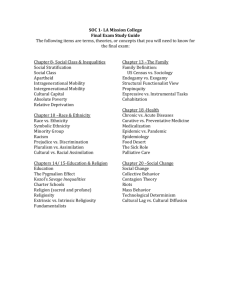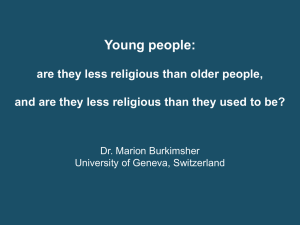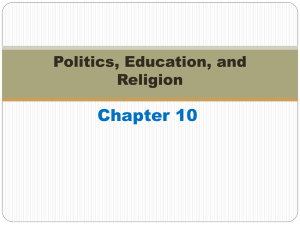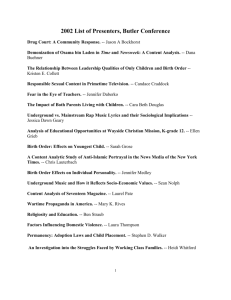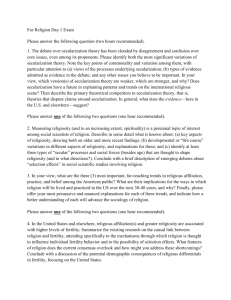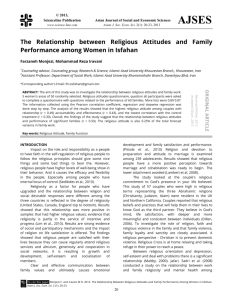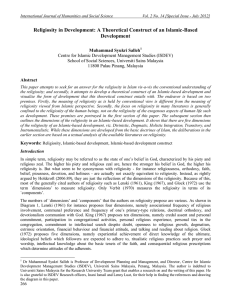Religion and Innovation
advertisement
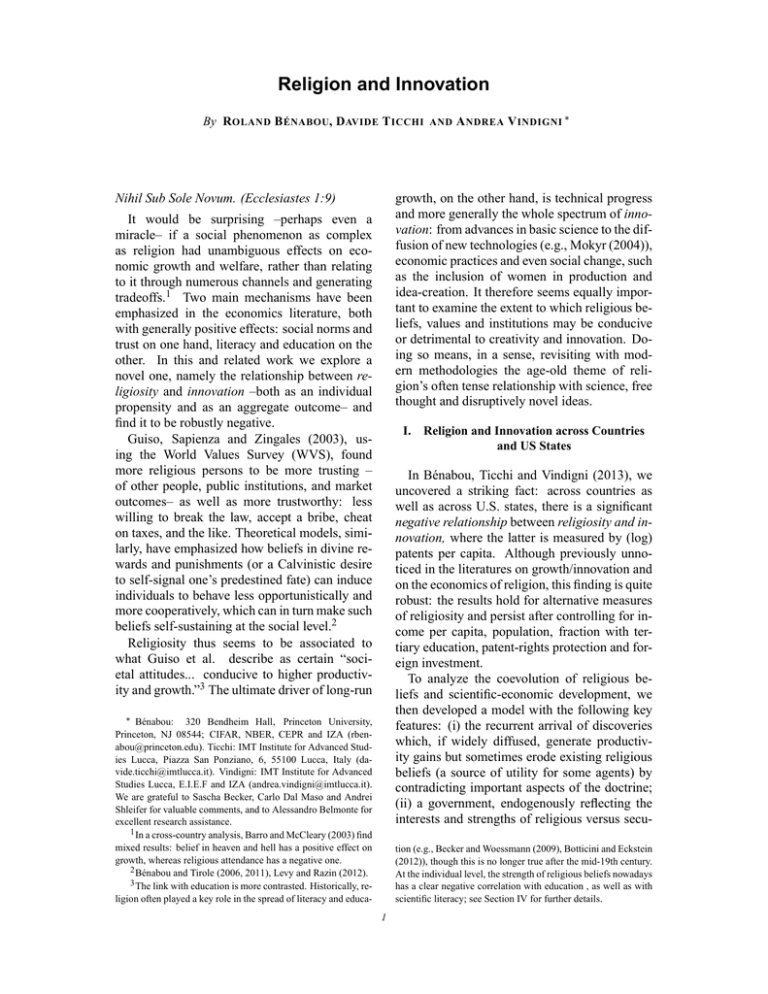
Religion and Innovation By ROLAND B ÉNABOU, DAVIDE T ICCHI AND A NDREA V INDIGNI growth, on the other hand, is technical progress and more generally the whole spectrum of innovation: from advances in basic science to the diffusion of new technologies (e.g., Mokyr (2004)), economic practices and even social change, such as the inclusion of women in production and idea-creation. It therefore seems equally important to examine the extent to which religious beliefs, values and institutions may be conducive or detrimental to creativity and innovation. Doing so means, in a sense, revisiting with modern methodologies the age-old theme of religion’s often tense relationship with science, free thought and disruptively novel ideas. Nihil Sub Sole Novum. (Ecclesiastes 1:9) It would be surprising –perhaps even a miracle– if a social phenomenon as complex as religion had unambiguous effects on economic growth and welfare, rather than relating to it through numerous channels and generating tradeoffs.1 Two main mechanisms have been emphasized in the economics literature, both with generally positive effects: social norms and trust on one hand, literacy and education on the other. In this and related work we explore a novel one, namely the relationship between religiosity and innovation –both as an individual propensity and as an aggregate outcome– and find it to be robustly negative. Guiso, Sapienza and Zingales (2003), using the World Values Survey (WVS), found more religious persons to be more trusting – of other people, public institutions, and market outcomes– as well as more trustworthy: less willing to break the law, accept a bribe, cheat on taxes, and the like. Theoretical models, similarly, have emphasized how beliefs in divine rewards and punishments (or a Calvinistic desire to self-signal one’s predestined fate) can induce individuals to behave less opportunistically and more cooperatively, which can in turn make such beliefs self-sustaining at the social level.2 Religiosity thus seems to be associated to what Guiso et al. describe as certain “societal attitudes... conducive to higher productivity and growth.”3 The ultimate driver of long-run I. Religion and Innovation across Countries and US States In Bénabou, Ticchi and Vindigni (2013), we uncovered a striking fact: across countries as well as across U.S. states, there is a significant negative relationship between religiosity and innovation, where the latter is measured by (log) patents per capita. Although previously unnoticed in the literatures on growth/innovation and on the economics of religion, this finding is quite robust: the results hold for alternative measures of religiosity and persist after controlling for income per capita, population, fraction with tertiary education, patent-rights protection and foreign investment. To analyze the coevolution of religious beliefs and scientific-economic development, we then developed a model with the following key features: (i) the recurrent arrival of discoveries which, if widely diffused, generate productivity gains but sometimes erode existing religious beliefs (a source of utility for some agents) by contradicting important aspects of the doctrine; (ii) a government, endogenously reflecting the interests and strengths of religious versus secu- Bénabou: 320 Bendheim Hall, Princeton University, Princeton, NJ 08544; CIFAR, NBER, CEPR and IZA (rbenabou@princeton.edu). Ticchi: IMT Institute for Advanced Studies Lucca, Piazza San Ponziano, 6, 55100 Lucca, Italy (davide.ticchi@imtlucca.it). Vindigni: IMT Institute for Advanced Studies Lucca, E.I.E.F and IZA (andrea.vindigni@imtlucca.it). We are grateful to Sascha Becker, Carlo Dal Maso and Andrei Shleifer for valuable comments, and to Alessandro Belmonte for excellent research assistance. 1 In a cross-country analysis, Barro and McCleary (2003) find mixed results: belief in heaven and hell has a positive effect on growth, whereas religious attendance has a negative one. 2 Bénabou and Tirole (2006, 2011), Levy and Razin (2012). 3 The link with education is more contrasted. Historically, religion often played a key role in the spread of literacy and educa- tion (e.g., Becker and Woessmann (2009), Botticini and Eckstein (2012)), though this is no longer true after the mid-19th century. At the individual level, the strength of religious beliefs nowadays has a clear negative correlation with education , as well as with scientific literacy; see Section IV for further details. 1 2 PAPERS AND PROCEEDINGS lar classes, that can allow such ideas and innovations to spread, or act to censor them and impede their diffusion; (iii) a Church or religious sector that can invest in adapting the doctrine to render it more compatible with the new knowledge. Three types of long-term outcomes emerge. The first is a “Secularization” or “WesternEuropean” regime, with declining religiosity, unimpeded scientific progress, a passive Church and high levels of taxes and secular public spending or redistribution. The second is a “Theocratic” regime with knowledge stagnation, extreme religiosity, a Church that makes no effort to adapt since its beliefs are protected by the state, and also high taxes but now used to subsidize the religious sector. In-between these two is a third, “American” regime, which generally combines unimpeded scientific progress and stable religiosity within an range where the state does not block new knowledge and the religious sector finds it worthwhile to invest in doctrinal adaptation. This regime features lower taxation than the other two, together with specific exemptions or other policies (e.g., laws regulating behavior) benefiting religious activities and citizens. Examining how strategic coalitions form across both economic and religious/secular lines, we also show that, in this “American” regime, a rise in income inequality can lead the rich to form a “Religious-Right” alliance with the religious poor and start blocking belieferoding discoveries and ideas. II. Religiosity and Openness to Innovation across Individuals In this paper we turn to the relationship, at the individual level, between religiosity and a broad set of pro- or anti-innovation attitudes. Working with large-scale individual datasets avoids some of the standard problems of cross-country regressions, and the use of a wide spectrum of attitudinal values broadens our investigation of religiosity and innovation beyond patent outcomes, as well as beyond the political-economy channel emphasized in our earlier work. A. Data and Key Variables Using all available waves of the World Values Survey (1980, 1990, 1995, 2000, and 2005), we regress eleven attitudinal measures of openness to innovation on five alternative measures MONTH YEAR of religiosity, together with a large number of sociodemographic controls.4 The measures of individual religiosity used are: identifying as a Religious Person, Belief in God, Importance of Religion and Importance of God in your life, and finally Church Attendance. All signs are (re)normalized so that higher values correspond to being more religious. Control variables include Age, Gender, selfidentified Social Class, Education level, Income level and dummies for religious denomination (the WVS has almost 90), country and year. Turning now to left-hand-side variables, we use three main categories, corresponding roughly to concentric circles around the specific issue of scientific and technical innovation. 1. Attitudes toward science and technology. We use respondents’ levels of (dis)agreement with the following three questions: (i) “We depend too much on science and not enough on faith” (E220); (ii) “Science and technology make our way of life change too fast” (E219); (iii) “The world is better off because of science and technology” (E234). 2. Attitudes toward new ideas, change, and risk-taking. The next five variables capture a person’s more general openness or aversion to novelty and change, originating from themselves or others. The first two focus on general novelty and personal creativity: (i) judging which are better, “Ideas that stood the test of time” or “New ideas” (E046); (ii) self-recognition in a hypothetical other described as “It is important to this person to think up new ideas and be creative; to do things one’s own way” (A189). The next two questions deal with attitudes toward general change and personal risk-taking: (iii) “I worry about difficulties changes may cause”, versus “I welcome possibilities that something new is beginning” (E047); (iv) selfrecognition in a hypothetical other described as “Adventure and taking risks are important to this person; to have an exciting life” (A195). The fifth variable captures the respondent’s perceived “locus of control”: agreement with 4 Our focus is with attitudes within the general public. There is also a (highly US-centered) sociology literature on the religious beliefs of scientists and other academics (who, as a whole, are considerably less religious than average). Ecklund and Scheitle (2007) offer a recent survey and empirical study. VOL. VOL NO. ISSUE RELIGION AND INNOVATION 3 TABLE 1— SCIENCE AND TECHNOLOGY, NEW VS. OLD IDEAS, CREATIVITY, RISK-TAKING, SHAPING OWN FATE, AND CHANGE Dependent variable: (1) Too much dependence on science vs faith: disagree (E220m) (2) Science & technology change life too fast: disagree (E219m) (3) Science & technology make world better off: agree (E234) (4) New ideas are better than old: agree (E046) (5) (6) Importance of Importance of new ideas adventure & being & creative: risk taking: agree agree (A189m) (A195m) (7) People shape their own fate: agree (F198) (8) Attitude toward change: welcome possibility (E047) Religious person - 0.232*** (0.047) 31978 0.140 - 0.181*** (0.039) 32413 0.067 0.032 (0.039) 32651 0.098 - 0.197*** (0.037) 40006 0.190 0.073*** (0.020) 35008 0.099 - 0.094*** (0.023) 34957 0.156 - 0.152*** (0.041) 35919 0.191 - 0.171*** (0.056) 14702 0.066 Importance of religion - 0.419*** (0.024) 32512 0.148 - 0.137*** (0.021) 32983 0.067 - 0.019 (0.020) 33199 0.096 - 0.013 (0.017) 41508 0.188 0.039*** (0.011) 35667 0.099 - 0.038*** (0.012) 35618 0.155 - 0.163*** (0.021) 36577 0.191 - 0.075*** (0.026) 15853 0.061 - 0.131** (0.063) 39276 0.195 0.067 (0.456) 2360 0.044 - 0.903* (0.522) 2361 0.080 - 1.311* (0.750) 2360 0.029 - 0.424*** (0.082) 12132 0.059 - 0.001 (0.006) 40634 0.191 0.015*** (0.004) 35598 0.099 - 0.022*** (0.004) 35550 0.155 - 0.045*** (0.008) 36533 0.191 - 0.025** (0.010) 14494 0.057 Belief in God Importance of God - 0.144*** (0.009) 32466 0.149 - 0.094*** (0.007) 32921 0.072 - 0.046*** - 0.007 (0.009) (0.007) 30427 30883 0.141 0.069 Notes: OLS estimates for alternative measures of Church attendance 0.024*** (0.007) 33162 0.098 - 0.002 - 0.022*** 0.024*** - 0.006 (0.007) (0.007) (0.004) (0.004) 31198 41231 33279 33249 0.094 0.190 0.101 0.164 religiosity. Robust standard errors in parentheses, followed by - 0.011 - 0.048*** (0.007) (0.011) 34177 16107 0.164 0.068 Number of observations and Adjusted R2 both in italics. *Significant at 10%; **significant at 5%; ***significant at 1%. All regressions include controls (not reported) for sex, age, education, social class, income, town size, religious denomination, country and year. Because of the absence of observations, specifications with Belief in God have not been included in Columns (1)-(3) and regressions in Column (8) only include controls for sex, age, country and year “Everything is determined by fate”, versus “People shape their fate themselves” (F198). 3. Child qualities. WVS respondents were presented with a list of eleven “Qualities that children can be encouraged to learn at home,” and asked to pick the five they considered “especially important”. We selected those most directly related to our inquiry, namely Imagination (A034), Independence (A029) and Determination / Perseverance (A039). III. Results Tables 1 and 2 show estimates and standard errors for each of the five alternative religiosity variables, estimated from separate regressions. Those for the control variables are not reported here due to space constraints, but can be found in tables provided in the online Appendix. Science and Technology. For two of the three attitudinal variables, all five measures of religiosity are consistently associated with more negative views of scientific progress. As shown in Columns 1-3 of Table 1, someone who identifies as a Religious Person, or who reports a greater Importance of Religion, Importance of God or Church Attendance, is significantly more likely ( p < 1%) to think that “we depend too much on science and not enough on faith” and that these “make life change too fast”. For the third question –whether the “world is better off because of science and technology”, in contrast, the results vary in sign across measures of religiosity and are generally not significant. New Ideas, Change and Risk-Taking. In Columns 4-8 of Table 1 we turn to more general indicators of openness to new ideas, change, risk-taking and agency. Of the five pro-novelty attitudes, four have a consistently negative and almost always highly significant relationships to each of the five indicators of religiosity. Such is the case for “New Ideas Better than Old Ones”, “Importance of Risk Taking”, belief that “People Shape their Own Fate” and “Welcoming vs. Worrying about Change”. The one exception is self-identification with a person described as attaching high importance to “Having New Ideas and Being Creative”, for which religiosity measures have a positive and significant effect. While it should certainly be kept in mind as a caveat to the other results, this is in fact the only one among the eleven “innovationfriendliness” variables for which the negative relationship with religiosity reverses, thus repre- 4 PAPERS AND PROCEEDINGS senting somewhat of a puzzle.5 IV. TABLE 2— MOST IMPORTANT QUALITIES FOR CHILDREN TO HAVE Dependent variable: Religious person (1) Importance of child independence (A029) - 0.045*** (0.005) 93028 0.141 (2) Importance of child imagination (A034) - 0.032*** (0.004) 93028 0.067 MONTH YEAR (3) Importance of child determination (A039) - 0.041*** (0.005) 89348 0.060 Importance of religion - 0.040*** (0.002) 95902 0.145 - 0.024*** (0.002) 95902 0.068 - 0.047*** (0.002) 92200 0.064 Belief in God - 0.054*** (0.010) 58294 0.146 - 0.038*** (0.009) 58294 0.067 - 0.066*** (0.011) 55545 0.065 Importance of God - 0.016*** (0.001) 94827 0.145 - 0.008*** (0.001) 94827 0.068 - 0.013*** (0.001) 92078 0.062 - 0.009*** - 0.006*** - 0.008*** (0.001) (0.001) (0.001) 93242 93242 89536 0.141 0.069 0.061 Notes: OLS estimates for alternative measures of religiosity. Robust standard errors in parentheses, followed by Number of observations and Adjusted R2 both in italics. *Significant at 10%; **significant at 5%; ***significant at 1%. All regressions include controls (not reported) for sex, age, education, social class, income, town size, religious denomination, country and year. Church attendance Shaping The Minds of Children. We turn now to the traits and qualities which adults think are most important to impart to children. The results, across all fifteen specifications in Table 2, are very clear-cut: all five measures of religiosity are negatively and significantly ( p < 1%) associated with the importance attached to children having Imagination, Independence, and Determination/Perseverance. Sociodemographic Controls. In all fiftytwo specifications we estimated, having higher Income, a lower Age and being Male always have the expected sign –pro-science, innovation, change, risk, etc.. The same is true for Education, with only a handful of exceptions, while the sign for Social Class is less consistent but most of the time positive. Women display a lower taste for risk (in line with the experimental literature) and novelty-seeking; they value a child’s independence more than males, but their imagination and determination/perseverance less. 5 One also notes that: (i) the raw correlations of E047 with religiosity indicators are significantly negative; (ii) Unlike the other ten attitudinal questions, its distribution is highly skewed: 75% of people respond “very much like” to “somewhat like”, far fewer “a little like”, and almost none “not like/not at all like”. Related literature Tolerance and Creativity. Acceptance of new ideas, change, risk, imagination or personal independence is arguably related to the tolerance of differences, be they in beliefs, cultural practices, or lifestyles. Florida (2005) argues for a link between “social diversity” and innovation, showing that, in the contemporary U.S., the share of coupled gay households in a city’s or region’s population is a strong predictor of the local concentration of high-tech industries, relative to the national average.6 Risk-Aversion. A willingness to take risks is clearly important to undertake investments, both individual and collective, especially in new technologies and social arrangements. Using panel data on immigrants to Germany, Bartke and Schwarze (2008) find religiousness to be a significant predictor of risk aversion, whereas nationality of origin is insignificant. Views and knowledge of science and technology. Gaskell et al. (2005) analyzed surveys conducted in the United States, Canada, and Europe about what rules should govern science and technology. Religious beliefs were found to be significantly related to thinking that decisions should be: (i) the views of the public, rather than left to the experts; (ii) based on moral and ethical issues, rather than on scientific evidence of risk and benefit. In the 2006 General Social Survey, respondents were given a 13-item test of basic scientific knowledge and reasoning. Controlling for demographics, education, income, region, and rural residence, Sherkat (2011) found greater religiosity to be clearly associated with lower scientific literacy.7 Human capital. Across people as well as places, the strength of religious belief is strongly negatively correlated with education (especially for “literalist” beliefs in miracles, the devil, or the inerrancy of the Bible; see, e.g., Glaeser and Sacerdote (2009) and Sherkat (2011)). Religious attendance, on the other hand, is shown by the first set of authors to be positively corre6 On the theory side, Corneo and Jeanne (2009) model the equilibrium degree of tolerance in society, while Esteban, Levy and Mayoral (2014) study the economic consequences of religious restrictions imposed on everyone’s consumption choices. 7 In experiments, Gervais and Norenzayan (2012) and Shenhav, Rand and Greene (2011) show that priming analytical thinking reduces feelings of religiosity and belief in God. VOL. VOL NO. ISSUE RELIGION AND INNOVATION lated with education (except in former communist countries), particularly in the U.S.8 All our regressions control for education, and using attendance always leads to the same results as the four other, belief-based, measures of religiosity. V. Conclusion Using all five waves of the World Values Survey, we examined the relationships between eleven indicators of openness to innovation, broadly defined (e.g., attitudes toward science and technology, new versus old ideas, general change, personal risk taking and agency, imagination and independence in children) and five measures of religiosity, involving both beliefs and attendance. Across the fifty-two regression specifications (with controls for sociodemographics, country and year), greater religiosity was almost uniformly and very significantly associated to less favorable views of innovation. In follow-up work, we plan to examine differences in these attitudes across denominations. Mechanisms of causality and/or self-selection remain of course very much open issues at this stage, and deserving of further investigation. VI. References Barro, Robert J. and Rachel M. McCleary (2003) “Religion and Economic Growth Across Countries,” American Sociological Review, 68(5), 760-781. Bartke, Stephan, and Reimund Schwarze (2008) “Risk-Averse by Nation or by Religion? Some Insights on the Determinants of Individual Risk Attitudes,” SOEP Papers on Multidisciplinary Panel Data Research, Berlin. Becker, Sascha O. and Ludger Woessmann (2009) “Was Weber Wrong? A Human Capital Theory Of Protestant Economic History,” Quarterly Journal of Economics, 128(4), 531-596. Bénabou, Roland, Davide Ticchi and Andrea Vindigni (2013) “Forbidden Fruits: The Political Economy of Science, Religion and Growth,” Princeton University, Research Paper No. 0652014, Dietrich Economic Theory Center. Bénabou, Roland and Jean Tirole (2006) “Belief in a Just World and Redistributive Politics,” 8 Rather than a specifically religious phenomenon, this is seen as reflecting the general impact of education on “sociability”, as also measured by most forms of secular social capital. 5 Quarterly Journal of Economics, 121(2), 699746. Bénabou, Roland and Jean Tirole (2011) “Identity, Morals and Taboos: Beliefs as Assets,” Quarterly Journal of Economics, 126, (2011), 805-855. Botticini, Maristella and Zvi Eckstein (2012) The Chosen Few: How Education Shaped Jewish History, 70-1492. Princeton, NJ: Princeton University Press. Corneo, Giacomo and Olivier Jeanne (2009) “A Theory of Tolerance,” Journal of Public Economics, 93, 691-702. Ecklund, Elaine and Christopher Scheitle (2007) “Religion among Academic Scientists: Distinctions, Disciplines, and Demographics, Social Problems, 54(2) 289–307. Esteban, Joan, Levy, Gilat and Laura Mayoral (2014) “Liberty, Equality, Religiosity,” LSE working paper, September. Florida, Richard (2005) Cities and The Creative Class. Routledge, NY: New York. Gaskell, George, Edna Einsiedel, Hallman, William, Hornig Priest, Susanna, Jackson, Jonathan and Johannus Olsthoorn (2005) “Social Values and the Governance of Science,” Science, 310, 1908-1909. Gervais, Will and Ara Norenzayan (2012) “Analytic Thinking Promotes Religious Disbelief,” Science, 336, 493-496. Glaeser, Edward L. and Bruce I. Sacerdote (2008) “Education and Religion,” Journal of Human Capital, 2(2), 188-215. Guiso, Luigi, Sapienza, Paola and Luigi Zingales (2003) “People’s Opium? Religion and Economic Attitudes,” Journal of Monetary Economics 50(1), 225-282. Levy, Gilat and Ronny Razin (2012) “Religious Beliefs, Religious Participation, and Cooperation,” American Economic Journal: Microeconomics, 4(3), 121-151. Mokyr, Joel (2004) The Gifts of Athena: Historical Origins of the Knowledge Economy, Princeton, NJ: Princeton University Press. Shenhav, Amitai, Rand, David G. and Joshua D. Greene (2011) “Divine Intuition: Cognitive Style Influences Belief in God,” Journal of Experimental Psychology, 141(3), 423-428. Sherkat, Darren (2011) “Religion and Scientific Literacy in the United States,” Social Science Quarterly, 92(5), 1-17.
